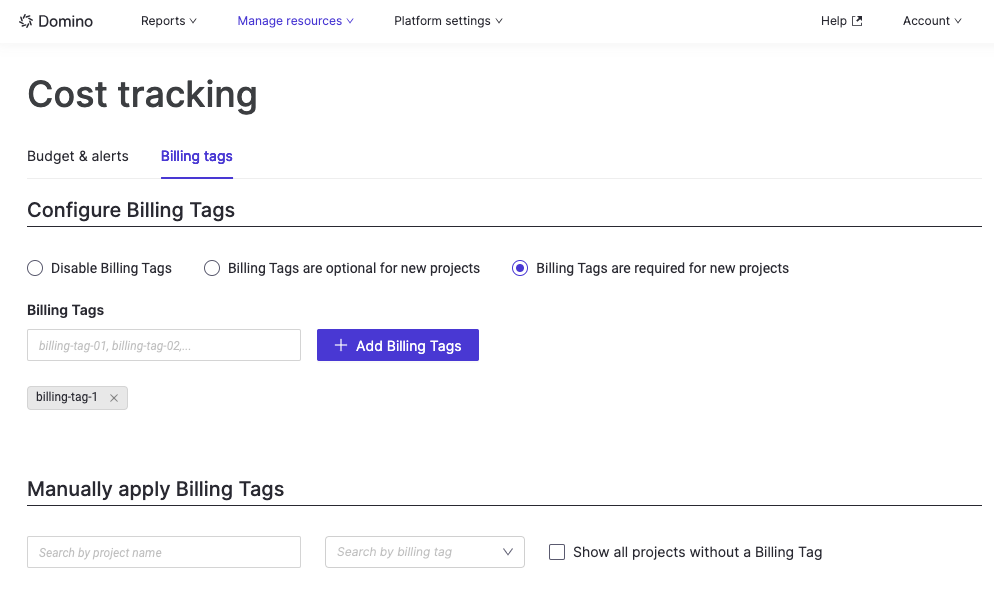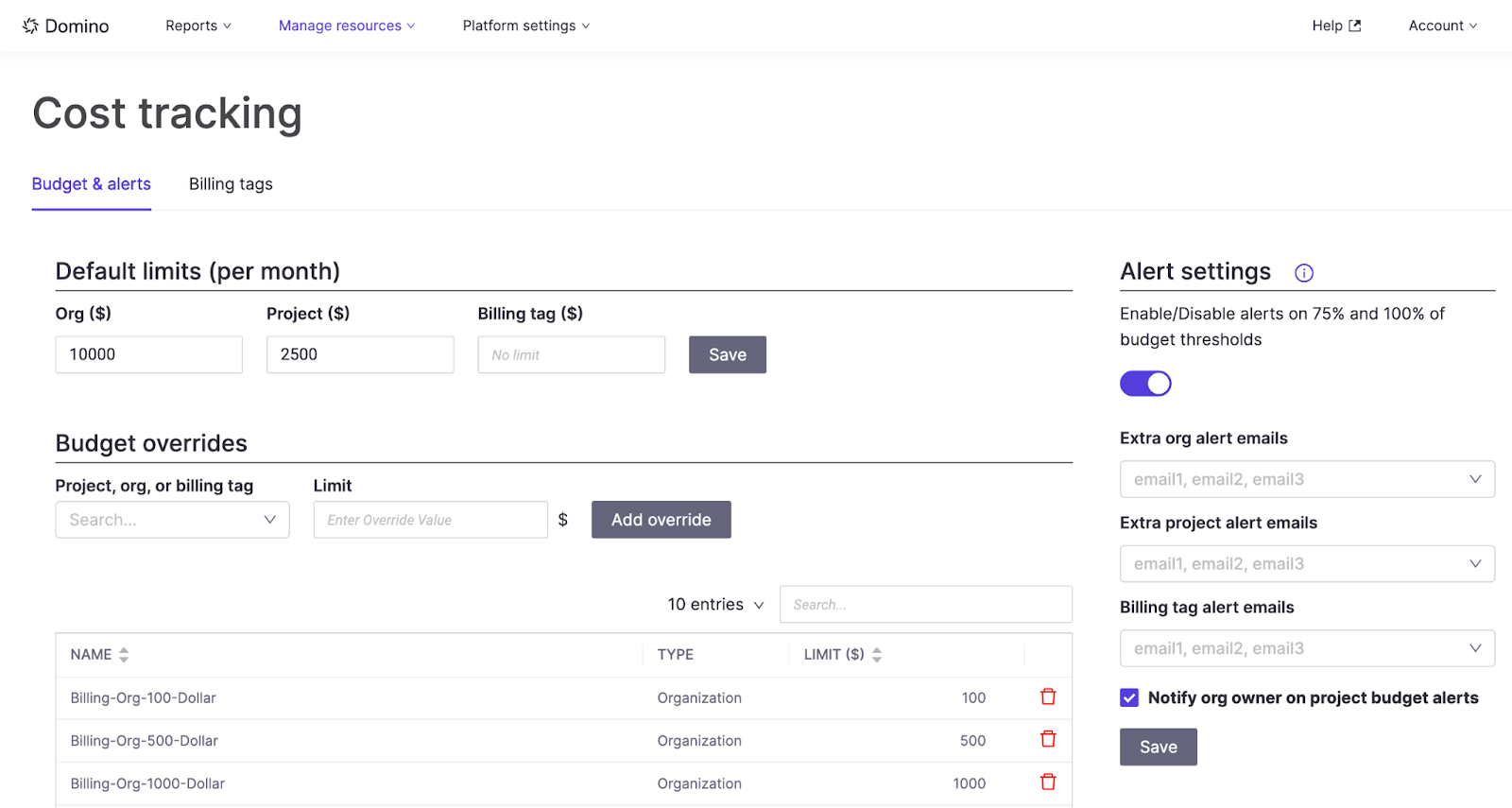You can use Domino Cost Center to establish budgets and send alerts to team members when they approach their spending limits on compute and storage resources. The addition of Billing Tags gives you added flexibility to track and manage project costs horizontally across your organization.
These features make it easier to track costs across different projects. Administrators can also set limits on the amount of storage for Datasets.
You can aggregate Cost Center or organization usage by using billing tags within Domino. Billing tags are a way of tagging projects so that they can be grouped by tag for accounting purposes. Projects may have multiple billing tags, and Administrators have the option to require the use of billing tags or not. To create billing tags:
-
Go to Admin > Manage resources > Cost tracking > Billing tags.
-
In the Configure Billing Tags section, you can set the Billing Tag feature to
Disabled,Optional, orRequiredfor new projects. Existing projects are unaffected, but you can still apply billing tags to them manually. -
For Billing Tags, enter one or more names and click Add Billing Tags.

After the billing tags are created, you can filter available projects and assign billing tags to them using the Manually apply Billing Tags field. This is useful for adding a newly defined billing tag to an existing project.
Budgets help control costs for organizations and projects by preventing overspending. By default, all projects and organizations have no budget limit. To set and configure your budgets:
-
Go to Manage Cost.
-
Go to Admin > Manage resources > Cost tracking > Budget & alerts.
-
In the Default Limits section, set a default monthly (by calendar month) budget that applies to all organizations, projects, or billing tags.
-
Use Budget Overrides to change the default budget limits for specific organizations, projects, or billing tags.

Alerts notify stakeholders when expenses for their organizations are nearing the budget threshold. These alerts are delivered through both Domino notifications and email.
Alerts are not configured by default. Billing tag notifications are only sent by email and require email to be configured to allow alerts. To set and configure alerts:
-
Go to Admin > Manage resources > Cost tracking > Budget & alerts.
-
Under Alert Settings, select Alert on 75% and 100% of budget thresholds to enable alerts.
-
Add additional emails to receive notifications.
-
Go to Platform settings > Email to configure your email and allow email alerts.
Domino sends out daily notifications when 75% of the budget is reached.
Admins can also use configuration keys related to read-write Datasets to set limits and quotas on the amount of storage used by Datasets, saving money on storage expenses and monitoring usage.
For more information, please get in touch with Domino Support.
Set Dataset snapshot limits
When a Dataset reaches the snapshot limit, users receive an error message when they attempt to create an additional snapshot.
To limit the number of snapshots per Dataset, please reach out to Domino Support.
You must delete old snapshots or increase the limit before writing additional snapshots.
Override snapshot limits
You can authorize individual projects to ignore the snapshot limits that you set:
-
Go to the Project that you want to set snapshot limits on.
-
Go to Settings > Hardware & Environment.
-
Select the Ignore Dataset Limits checkbox.
Selecting Ignore Dataset Limits does not impact any quotas for which hard limits have been set.
Dataset sizing
When a user interacts with a dataset by uploading a file, deleting a file, creating a snapshot, or ending a run, the dataset is queued to be sized in the background. This allows large datasets to be sized quickly and accurately without timing out.
To avoid multiple expensive calls to resize the dataset, Domino waits seven days between each sizing request.
The Configuration records page has more information about Dataset configuration keys.
Dataset quota limits
You can also set dataset quotas to notify users if their datasets exceed the allocated storage. Quotas are "soft" quotas, meaning they never block users from creating more datasets or snapshots.
There are two types of dataset quotas. To set quotas:
-
Navigate to Admin > Datasets.
-
Choose the type of quota to set:
-
Global quota: Creates a limit that applies to every user in the deployment. -
Quota override: Sets individual limits on specific users and overrides theglobal quota.
-
Quota overrides only work when a global quota is also configured.
Dataset quota calculations
Domino calculates quotas based on a user’s total dataset storage footprint, which includes all the Datasets they own, except for datasets in specific states:
-
MarkedForDeletion -
DeletionInProcess -
Deleted -
Failed
The size of a dataset is determined by summing the sizes of each snapshot within the dataset, excluding any deleted snapshots. If a dataset has multiple owners, the size of that dataset is counted towards each owner’s quota.
Dataset Roles has more information about how the roles work together.
Quota notifications
As an administrator, you can configure the thresholds listed in the Read-write Datasets configuration keys.
When a user reaches certain thresholds of their quota, they receive notifications, emails, and UI warnings on Dataset pages. These actions are triggered by the following events:
-
Uploading files to a Dataset (both UI and CLI).
-
Creating a snapshot (both UI and CLI).
-
Creating a Dataset from a snapshot (both UI and CLI).
-
Deleting files from a Dataset in the UI.
When a user receives an email about their Dataset storage quota, administrators automatically receive a similar email. You can also add additional recipients under Quota Notifications.
Here are some other ways Domino Cost Center can help you optimize the performance of your AI projects while managing cloud expenditures:
-
Automatically allocate usage-based costs to Projects, organizations, and users.
-
Optimize Dataset storage usage to reduce cloud storage costs.
-
Generate chargeback/showback reports and use APIs to facilitate cost recovery across organizations and engage with high-expenditure users to optimize infrastructure usage.
